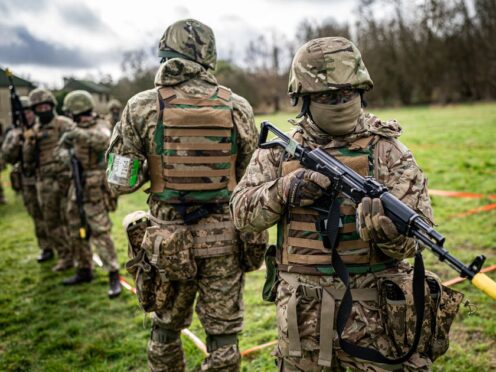Falling levels of armed forces recruitment is a national security crisis, ministers heard.
Backbench Conservative MP Danny Kruger told MPs that for every five people recruited, eight are leaving the services.
Labour former defence minister Kevan Jones called for a “radical revolution” in the way the armed forces recruits and employs people.
During a debate on defence spending, Mr Kruger said: “The Public Accounts Committee, I understand, heard for every five people recruited to the armed services, eight are leaving.

“That is a national security crisis, it is not just a problem for recruitment, it is an absolutely profound security risk.”
Mr Kruger argued the UK must “restore the mass” to its armed forces, telling the Commons: “We need to get back towards 80,000, 90,000 regular forces, we need to grow the reserve force – 30,000 is not enough even if that 30,000 were real, which I don’t believe it is – we have to significantly grow the reserve force.
“I think a campaign to grow our reserves is necessary not just for its own sake, but it’s a great exercise in communication to the public about the imperative of us all to step up and play our role in the defence of our country.”
The MP for Devizes added: “We need a very quick total review of the people issue in our armed forces. It can be done quickly and all it probably entails is an amalgamation of all the work that has been done by others, but I would like to see it with a great degree of urgency.”
Labour MP for North Durham Mr Jones said: “There has got to be a real radical revolution in the way in which armed forces not only recruit people, but actually employ people.
“The number of 18-year-olds is going down, we’re going to have more flexible employment models where people can leave, come back in, have career breaks, things like that.
“Unless we do that, we’re not going to actually get any individuals to join our armed forces.”

Conservative former defence minister Sir Jeremy Quin suggested more investment in housing could address the “crisis in retention and recruitment”.
The Defence Committee chairman also called for long-term planning to be prioritised through sustained, effective and increased investment in defence.
Sir Jeremy said: “What the UK needs is not a diminution of our ambition, it is an increase in our investment. I’m acutely aware in saying that of the regular charge that additional UK investment in defence is wasteful if the (Ministry of Defence) does not get its house in order on procurement.”
The Horsham MP added: “While better buying will of course help, this is alongside sustained, effective and increased investment. Investment horizons on priority projects must stretch well beyond annual commitments to allow proper planning.
“We will make savings if the services don’t gamble all their chips on the delivery of the perfect platform while it’s their turn – they won’t do that if they know that funding will be there for upgrades.
“Industry on that basis will invest alongside, will work with SMEs (small and medium-sized enterprises) and train the workforce we need, if they know that we are marching together for the long term rather than at the end of every order they may well be marched off the end of the cliff.”
Labour former minster Dame Meg Hillier said the Ministry of Defence “too often falls short” on spending taxpayers’ money effectively.
The chairwoman of the Public Accounts Committee said taxpayers’ money is given to the Government “trusting that it will be spent well, but sadly we see too often that it is not spent as well as it should be”.
She added: “We see money going in, but not the capability coming out that we require.”
Dame Meg (Hackney South and Shoreditch) continued: “For all the time I have been on the Public Accounts Committee, that’s 13 years this year, the Ministry of Defence has been led by optimism bias.
“It’s now pressing on, not just with optimism, but on the sniff of optimism, so little left in that approach that will actually deliver. We must call this out and call a spade a spade, it can only deliver what is affordable.
“Either the money goes in or they trim what they are trying to do, because this approach of trying to do everything all at once and not be able to afford it is just not going to work.”
George Galloway, Workers Party of Britain MP for Rochdale, said: “There’s plenty of jingo but of course the men, the ships and the money are more difficult to find.
“We haven’t the men, we haven’t the ships, we haven’t the money, so why are we picking enemies? I’ve lost count of the number in the course of this debate that we are either already fighting or may have to get ready to fight. That’s the absurdity, the Alice In Wonderland nature of this debate.”
Defence minister James Cartlidge said the UK’s armed forces are “more than ready”, as he defended the Government’s record.
He said: “If we increase defence by a significant amount, then the money does have to come from somewhere.
“An increase from the current level of around 2.3% to 3% is £20 billion, that’s not a small amount of taxpayers’ money; even to 2.5% is an extra £6 billion.
“It’s Government policy to support that but to do so when we believe the economy can support it over a sustained basis.”
